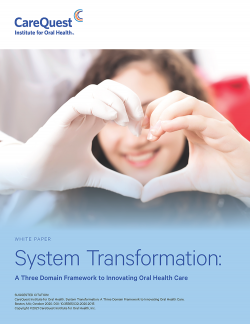Dentistry is changing rapidly and the COVID-19 pandemic has highlighted key opportunities within the oral health care system. A paper by CareQuest Institute for Oral Health outlines a Three Domain Framework that creates a new model in dentistry, a roadmap for the future that will be cost-effective, efficient, and more equitable.
Discover a Better Way Forward
This Three Domain Framework builds on health promotion and disease prevention while supporting value-based care. Informed by the work of the Community Oral Health Transformation (COrHT) Learning Community, the Framework creates a primary care-like structure for oral health care delivery. It facilitates value-based payment models and enables patients to invest in their oral health.
|
|
Tele-PreventionDomain One builds an accessible evidence-based virtual care delivery approach to accompany oral health care delivery that applies technology for enhanced disease prevention and whole-person health. |
|
|
Minimally Invasive CareDomain Two focuses on minimally invasive care that reverses or slows early disease stages using a program of anticipatory guidance and collaborative decision-making with patients. |
|
|
Integrated and Personalized CareDomain Three introduces personalized oral health care that prolongs the life of hard and soft tissues by reducing tooth/tissue mortality through risk stratification, medical-dental integration, the utilization of predictive analytics and safe, individualized surgical intervention. |
The paper includes a thorough examination of each Domain, including clinical guidance; cost and financial implications; relative advantages for patients, providers and payors; and analyses of strengths, weaknesses, opportunities and threats. It concludes with a list of concrete steps for short- and long-term implementation.
Oral health professionals and dentistry, as an industry, are at a crossroads: either return to the traditional fee-for-service surgical model or embrace a new paradigm of oral health care that focuses on overall health as an outcome. This paper, which includes contributions from more than 110 oral health leaders, presents that new paradigm.
